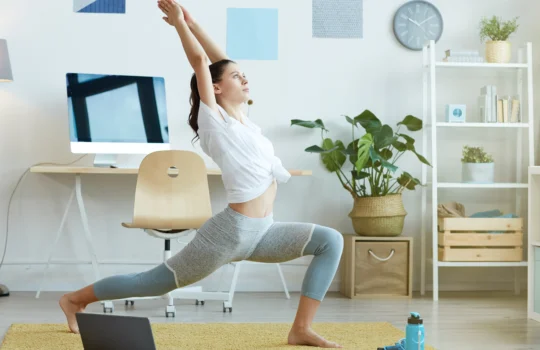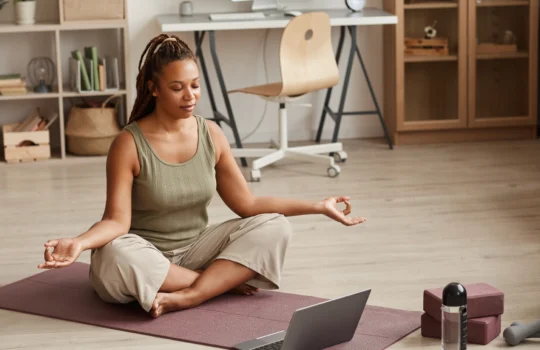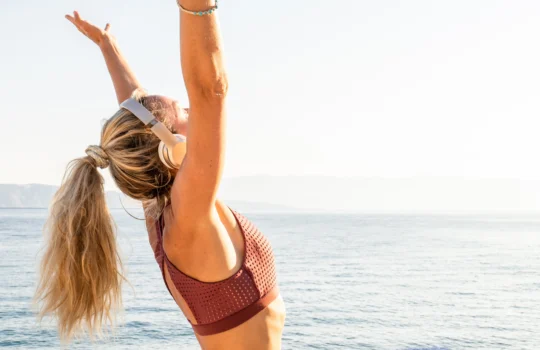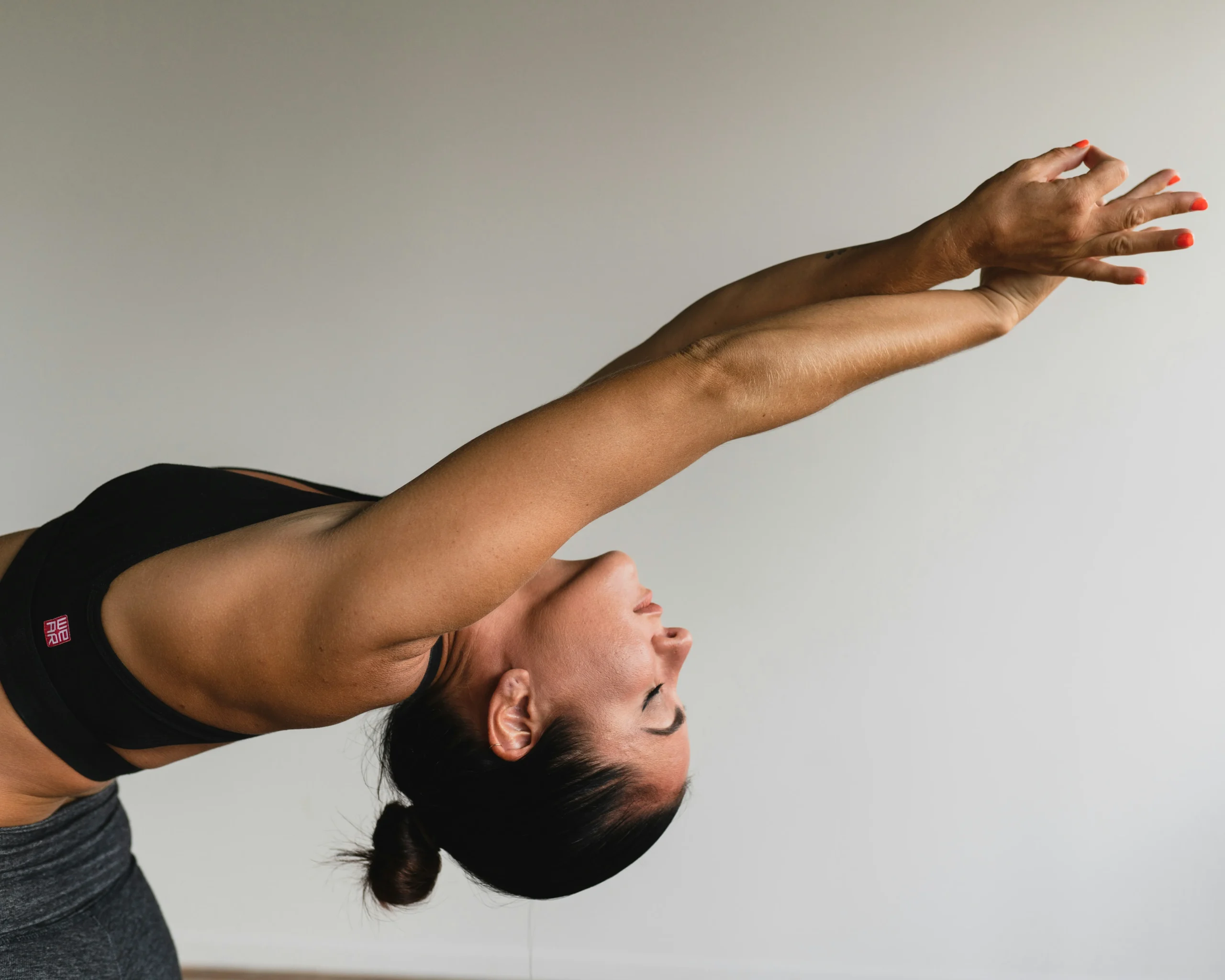Whether you’re looking to become more flexible, de-stress, or just find a fun way to exercise, beginner yoga routine has got you covered. But before you jump in, let’s make sure you’re starting on the right foot with beginner yoga routine. (or should we say, the right pose? 😉).
We’ve all seen those Instagram yogis and thought, “How do they do that?” Well, spoiler alert: they didn’t start out that way! To help you get started and avoid the most common pitfalls, we’ve put together the ultimate list of seven do’s and don’ts for your beginner yoga routine. Let’s make your journey into yoga a smooth and enjoyable ride. Ready, set, namaste! 🌟
Table of Contents
Do: Create a Comfortable Practice Space

Alright, let’s set the scene for your yoga adventure! 🕉️ Imagine a peaceful, clutter-free oasis where you can focus solely on your practice. Creating a comfortable practice space is essential for a successful beginner yoga routine. Here’s how to make your yoga nook perfect:
Find Your Zen Den
First things first, pick a quiet spot in your home where you won’t be disturbed. It could be a corner of your bedroom, living room, or even a cozy spot on your balcony. The key is to find a space where you feel relaxed and can concentrate.
Roll Out the Red (Yoga) Carpet
Invest in a good-quality yoga mat that offers enough cushioning and support. Your mat is your yoga sanctuary, so choose one that’s comfortable and grippy to prevent any slips during poses.
Props to You!
Yoga props like blocks, straps, and bolsters are your new best friends. These handy tools can make poses more accessible and help you maintain proper alignment. Don’t be shy about using them—props are here to support you, not to mention they make you look like a pro!
Set the Mood
Ambiance is everything! Soft lighting, calming scents, and soothing music can transform your space into a serene yoga haven. Light a few candles or use a diffuser with essential oils like lavender or eucalyptus to create a relaxing atmosphere.
Keep It Clean and Clutter-Free
A tidy space equals a tidy mind. Clear away any distractions and keep your area organized. A clean, clutter-free environment will help you stay focused and enjoy your practice without any interruptions.
By creating a comfortable practice space, you’re setting the stage for a successful and enjoyable yoga journey. Now, get ready to roll out your mat and dive into the next step of your beginner yoga routine! 🌿🧘♀️✨
Don’t: Skip the Warm-Up
Hold up! 🚦 Before you dive headfirst into those yoga poses, there’s one crucial step you can’t afford to skip: the warm-up. Trust us, your body will thank you! Warming up properly is essential for a safe and effective beginner yoga routine. Here’s why and how to get it right:
Why Warm-Up?
Warming up preps your muscles and joints for the work ahead. It increases blood flow, enhances flexibility, and reduces the risk of injury. Think of it as the appetizer before the main course—essential for a great experience! 🥗➡️🍝
Simple Warm-Up Moves
You don’t need to be a fitness guru to warm up properly. Here are some easy exercises to get you started:
- Neck Rolls: Gently roll your head from side to side, loosening up those neck muscles.
- Shoulder Shrugs: Lift your shoulders up towards your ears and then roll them back and down. Repeat a few times to release tension.
- Gentle Twists: Sit or stand with a straight spine and slowly twist your torso to the right, then to the left. This helps wake up your spine and core.
- Cat-Cow Stretch: On all fours, alternate between arching your back (Cow) and rounding it (Cat). This dynamic movement is great for your spine and warms up your back muscles.
Integrate Warm-Ups into Your Routine
Make your warm-up a non-negotiable part of your practice. Spend at least 5-10 minutes warming up before diving into your poses. It’s a small time investment that pays off big time in terms of safety and performance.
Listen to Your Body
As you warm up, tune into how your body feels. Are there any tight spots or areas of discomfort? Spend a little extra time gently stretching and loosening those areas. This mindful approach helps prevent injuries and ensures a smoother practice.
Skipping the warm-up is like trying to run a marathon without training—you’re just asking for trouble. So, take a few minutes to warm up properly, and your body will be primed and ready for an amazing yoga session. 🌞🧘♂️🧘♀️
Do: Focus on Proper Alignment
Alright, future yoga masters, this one’s a biggie! 🌟 If you want to avoid injuries and get the most out of your poses, focusing on proper alignment is absolutely key. Here’s how to make sure you’re hitting those postures perfectly:
Why Alignment Matters
Proper alignment isn’t just about looking good (though it does help you feel like a yoga pro). It ensures that you’re engaging the right muscles and protecting your joints, which helps prevent injuries and maximizes the benefits of each pose. Think of it as building a solid foundation for your beginner yoga routine. 🏛️
Tips for Perfect Alignment
- Start Slow and Steady
- Don’t rush through the poses. Take your time to get into each position correctly. It’s better to do fewer poses well than to rush through many with poor form.
- Use a Mirror or Record Yourself
- Practicing in front of a mirror can help you see if your alignment is correct. Alternatively, record yourself and review the video to spot any adjustments needed.
- Mind Your Feet and Hands
- In many poses, the position of your feet and hands is crucial. For example, in Downward Dog, your hands should be shoulder-width apart, and your feet should be hip-width apart, with fingers spread wide for a stable base.
- Engage Your Core
- A strong core supports almost every yoga pose. Engage your abdominal muscles to help maintain balance and protect your lower back.
- Stack Your Joints
- Align your joints to avoid unnecessary strain. For example, in poses like Warrior I, your knee should be directly over your ankle. This helps distribute weight evenly and prevents joint stress.
- Listen to Your Instructor
- Whether you’re in a class or following a video, pay close attention to the instructor’s cues about alignment. They often provide valuable tips to help you adjust your form.
- Use Props and Modifications
- Don’t be afraid to use props like blocks, straps, and bolsters. They can help you achieve better alignment and make poses more accessible. For instance, if you can’t touch your toes in a forward bend, use a block to bring the floor closer to you.
Common Alignment Checkpoints
- Mountain Pose (Tadasana): Stand tall with feet hip-width apart, weight evenly distributed. Roll your shoulders back and down, engage your thighs, and lengthen through your spine.
- Warrior II (Virabhadrasana II): Ensure your front knee is over your ankle, back leg is straight, and arms are parallel to the floor, reaching out strongly.
- Plank Pose: Align your wrists under your shoulders, engage your core, and keep your body in a straight line from head to heels.
Listen to Your Body
Alignment isn’t one-size-fits-all. Everyone’s body is different, so it’s important to listen to your own and make adjustments as needed. If something feels off or painful, ease out of the pose and reassess your form.
Focusing on proper alignment will make your practice safer, more effective, and way more enjoyable. You’ll build strength and flexibility the right way, setting yourself up for long-term success in your yoga journey. So, take a deep breath, adjust that pose, and feel the difference! 🌈🧘♂️🧘♀️
Don’t: Push Yourself Too Hard
Hold up, eager yogi! 🛑 It’s awesome that you’re excited about your new yoga journey, but there’s one golden rule you absolutely must follow: don’t push yourself too hard. Yoga is all about balance, self-awareness, and patience. Here’s why taking it easy is key, and how to do it right:
Why You Shouldn’t Overdo It
Overexertion can lead to injuries, burnout, and frustration—all things you definitely want to avoid. Yoga is a practice of self-discovery and self-care, not a race or a competition. The goal is to find joy and balance, not to impress anyone (including yourself) by forcing your body into difficult poses before it’s ready.
Listen to Your Body
Your body is constantly giving you feedback. Listen to it! If a pose feels painful or overly strenuous, ease up or modify it. Discomfort is okay—pain is not. Yoga should challenge you, but it should never hurt. 🌟
Tips to Avoid Overdoing It
- Start with Beginner Poses
- Stick to poses designed for beginners. They build a strong foundation and prepare your body for more advanced poses in the future.
- Take Breaks When Needed
- There’s no shame in taking a break. Child’s Pose is a wonderful resting pose you can come back to anytime during your practice. It’s better to rest and then continue than to push through fatigue.
- Respect Your Limits
- Know and respect your body’s limits. Flexibility and strength come with time and consistent practice. Forcing a pose before you’re ready can lead to injuries.
- Use Modifications and Props
- Modifications and props aren’t just for beginners—they’re for everyone! They help you practice safely and effectively, ensuring you get the benefits of the pose without risking injury.
- Focus on Your Breath
- Your breath is a great indicator of how hard you’re working. If you find yourself holding your breath or breathing erratically, it’s a sign you need to ease up.
- Stay Present and Mindful
- Yoga is as much a mental practice as it is physical. Stay present and mindful in each pose. This awareness helps you notice when you’re pushing too hard and reminds you to be gentle with yourself.
The Journey Over the Destination
Remember, yoga is a journey, not a destination. Progress in yoga is measured by your personal growth and how you feel, not by achieving the most challenging poses. Celebrate the small victories, like touching your toes for the first time or holding a pose a little longer than before.
Benefits of Taking It Easy
By not pushing yourself too hard, you allow your body to adapt and grow at its own pace. This approach leads to sustainable progress and a more enjoyable practice. You’ll build strength, flexibility, and mindfulness without the setbacks of injury or burnout.
So, take it slow, breathe deeply, and enjoy the process. Yoga is about finding harmony within yourself, and that starts with treating your body with kindness and respect. Embrace the journey, and you’ll find that the rewards of beginner yoga routine come naturally with time and patience. 🌼🧘♀️🧘♂️
Do: Breathe Properly

Alright, let’s talk about something you’re already doing right now—breathing! 🌬️ While it might seem simple, proper breathing is a game-changer in your beginner yoga routine. It connects your mind and body, enhances relaxation, and boosts your overall practice. Here’s how to breathe like a true yogi:
Why Proper Breathing Matters
Breathing isn’t just about getting oxygen; it’s a vital part of your beginner yoga routine. Proper breathing can help you:
- Stay Present: Focusing on your breath keeps your mind anchored in the present moment.
- Increase Relaxation: Deep, mindful breathing activates the parasympathetic nervous system, promoting relaxation.
- Enhance Endurance: Controlled breathing can help you hold poses longer and more comfortably.
- Improve Flexibility: Deep breathing helps release tension, making it easier to stretch.
Techniques for Mindful Breathing
- Ujjayi Breath (Ocean Breath)
- This is the classic yoga breath. Inhale deeply through your nose, filling your lungs. Exhale through your nose while slightly constricting the back of your throat, creating a soft “ocean” sound. This breath helps you stay focused and calm.
- Diaphragmatic Breathing (Belly Breathing)
- Place one hand on your chest and the other on your belly. Inhale deeply through your nose, allowing your belly to rise as you fill your lungs. Exhale through your nose, letting your belly fall. This technique promotes deep, full breaths and relaxation.
- Nadi Shodhana (Alternate Nostril Breathing)
- Sit comfortably and use your right thumb to close your right nostril. Inhale deeply through your left nostril. Close your left nostril with your right ring finger, release your right nostril, and exhale through the right. Inhale through the right, then switch and exhale through the left. This breath balances the nervous system and calms the mind.
Incorporating Breath with Movement
Pairing your breath with your movements enhances the flow and effectiveness of your practice. Here’s how to sync them up:
- Inhale to Lengthen
- In poses where you stretch or lengthen, inhale deeply. For example, inhale as you reach your arms overhead in Mountain Pose.
- Exhale to Deepen
- In poses where you fold or twist, exhale fully. For example, exhale as you fold forward into a Forward Bend.
- Steady Rhythmic Breathing
- Maintain a steady and even breath throughout your practice. This helps you stay calm and focused, especially in challenging poses.
Practice Mindfulness
Mindful breathing is all about being aware of your breath and using it to enhance your practice. Pay attention to the quality of your breath—whether it’s smooth or ragged, deep or shallow. Use this awareness to adjust and improve your breathing technique.
Benefits of Proper Breathing
When you breathe properly during your beginner yoga routine, you:
- Reduce Stress: Deep, mindful breaths help lower cortisol levels, reducing stress and anxiety.
- Enhance Concentration: Focusing on your breath improves your concentration and mental clarity.
- Boost Energy: Proper breathing increases oxygen flow, boosting your energy levels.
- Improve Posture: Coordinating breath with movement encourages proper alignment and posture.
So, the next time you’re on your mat, remember to breathe deeply and mindfully. Proper breathing will transform your beginner yoga routine, making it more effective and enjoyable. Breathe in, breathe out, and let the magic of yoga unfold. 🌿🧘♀️🧘♂️
Don’t: Compare Yourself to Others

Here’s a golden nugget of wisdom for you: don’t compare yourself to others. Yoga is a personal journey, and everyone’s path looks different. Falling into the comparison trap can rob you of the joy and progress you’re meant to experience. Here’s why you should embrace your unique practice and how to do it:
Why Comparing Is a No-Go
Comparing yourself to others, whether in a class or on social media, can be discouraging and counterproductive. It’s important to remember that:
- Everyone Starts Somewhere: Even the most advanced yogis were beginners once. Everyone’s flexibility, strength, and progress happen at different rates.
- Yoga Is Personal: Your body, mind, and experience are unique. What works for someone else might not work for you, and that’s okay.
- Progress Looks Different: Small, consistent improvements are just as valuable as big leaps. Celebrate your own milestones, no matter how small they seem.
Tips to Avoid the Comparison Trap
- Focus on Your Practice
- Keep your attention on your own mat. Concentrate on how your body feels in each pose and what you need to adjust. This inward focus enhances your practice and keeps you grounded.
- Set Personal Goals
- Set achievable, personal goals that are meaningful to you. Whether it’s touching your toes or holding a balance pose for a few seconds longer, these goals will keep you motivated and focused on your own progress.
- Practice Mindfulness
- Use mindfulness techniques to stay present. When you notice your mind wandering towards comparison, gently bring it back to your breath and the sensations in your body.
- Embrace Your Journey
- Your yoga journey is uniquely yours. Embrace where you are right now and appreciate the progress you’re making. Remember, yoga is about growth, not perfection.
- Limit Social Media Exposure
- Social media can be a highlight reel of people’s best moments. If you find yourself feeling down after scrolling through yoga posts, take a break from social media or follow accounts that inspire and uplift you without sparking comparison.
- Join Supportive Communities
- Surround yourself with supportive and encouraging people, whether in a yoga class or an online community. Sharing your experiences and progress with others who understand and support you can be incredibly motivating.
Celebrate Your Individual Progress
Instead of comparing, celebrate your own achievements, no matter how small. Did you hold a pose a bit longer today? Did you find a little more ease in a stretch? Those are victories! Yoga is a journey of self-discovery and growth, and every step forward is worth celebrating.
The Bigger Picture
Yoga is about connecting with yourself, finding inner peace, and building strength and flexibility at your own pace. By avoiding comparisons, you allow yourself to fully experience and enjoy your practice. Remember, the only person you should be comparing yourself to is the person you were yesterday.
So, next time you’re on your mat, focus on your own journey. Embrace your progress, be kind to yourself, and enjoy every moment of your beginner yoga routine. Your unique path is beautiful and worthy of celebration. Namaste! 🌟🙏
Do: Stay Consistent
If there’s one secret to unlocking the true benefits of yoga, it’s consistency. Regular practice is key to making progress, building strength, and reaping all those amazing mental and physical benefits yoga has to offer. Here’s why staying consistent is crucial and how you can make it happen:
Why Consistency Matters
- Builds Strength and Flexibility: Like any physical activity, the more you practice yoga, the stronger and more flexible you become. Regular practice helps you see gradual, sustainable improvements.
- Enhances Mental Clarity: Consistent practice helps reduce stress and anxiety, improving your overall mental well-being. It’s like giving your mind a daily spa treatment! 🧘♀️🧘♂️
- Creates Habit: Making yoga a regular part of your routine turns it into a habit, making it easier to stick with over time. It becomes a natural part of your day, like brushing your teeth or having your morning coffee.
- Deepens Your Practice: Regular practice allows you to explore poses more deeply, understand your body better, and improve your technique over time.
Tips for Building a Consistent Yoga Practice
- Set a Schedule
- Pick specific days and times for your beginner yoga routine and stick to them. Consistency is easier when it’s part of your routine. Whether it’s every morning or a few evenings a week, find what works for you.
- Start Small
- If you’re new to yoga, start with short sessions. Even 10-15 minutes a day can make a big difference. As you get more comfortable, you can gradually increase the length of your practice.
- Create a Dedicated Space
- Having a dedicated yoga space at home can motivate you to practice regularly. Make it a place you enjoy being in, with your mat, props, and maybe some candles or calming music.
- Set Realistic Goals
- Set achievable goals for your practice. Whether it’s learning a new pose, improving your flexibility, or simply making it to the mat three times a week, setting goals helps keep you motivated.
- Track Your Progress
- Keep a yoga journal or use an app to track your practice. Note how you feel before and after each session, any progress you’ve made, and new poses you’ve learned. Seeing your growth over time can be incredibly motivating.
- Find a Yoga Buddy
- Practicing with a friend can keep you accountable and make yoga more fun. You can motivate each other, share tips, and celebrate progress together.
- Mix It Up
- Variety keeps things interesting. Try different styles of yoga, new poses, or follow various online classes. This keeps your practice fresh and exciting.
- Be Kind to Yourself
- Some days you might not feel like practicing, and that’s okay. Listen to your body and rest when you need to. Consistency is about regular practice over time, not perfection every day.
Benefits of Consistent Yoga Practice
Staying consistent with your beginner yoga routine brings numerous benefits:
- Improved Physical Health: Enhanced strength, flexibility, and balance.
- Better Mental Health: Reduced stress, anxiety, and improved focus.
- Increased Energy: Regular yoga practice can boost your energy levels and overall vitality.
- Greater Self-Awareness: Deepening your connection with your body and mind.
Consistency is the key to unlocking all the wonderful benefits yoga has to offer. So, roll out your mat regularly, stay committed, and enjoy the journey. Your body and mind will thank you! 🌿✨
Don’t: Ignore Pain

Let’s talk about something super important—pain. Yoga is all about finding balance and peace, but if you’re pushing through pain, you’re doing it wrong. Ignoring pain can lead to injuries and setbacks, so let’s make sure you’re practicing safely. Here’s why you should never ignore pain and how to tune into your body effectively:
Why You Shouldn’t Ignore Pain
- Prevents Injuries: Pain is your body’s way of signaling that something isn’t right. Ignoring it can lead to serious injuries that could sideline your practice for weeks or even months.
- Ensures Proper Form: When you push through pain, you might compensate with incorrect alignment, which can cause strain and discomfort in other areas.
- Promotes Long-Term Practice: By respecting your body’s limits, you ensure a sustainable practice that you can enjoy for years to come.
How to Recognize and Respond to Pain
- Listen to Your Body
- Pay close attention to how your body feels in each pose. Discomfort is normal, especially when trying something new, but sharp, intense, or persistent pain is not.
- Differentiate Between Discomfort and Pain
- Discomfort can happen when you stretch muscles that aren’t used to being stretched. Pain, on the other hand, is a signal that something is wrong. Learn to recognize the difference.
- Modify Poses as Needed
- Use props like blocks, straps, and bolsters to make poses more accessible and comfortable. Don’t hesitate to modify poses to suit your body’s needs.
- Take Breaks
- If you start to feel pain, come out of the pose and take a break. Child’s Pose is a great way to rest and reset. It’s better to take a moment to recover than to risk injury.
- Seek Professional Guidance
- If you’re consistently experiencing pain in certain poses, consider consulting a yoga instructor or physical therapist. They can help you adjust your technique and find solutions that work for your body.
Common Pain Points and How to Address Them
- Lower Back Pain
- Ensure you’re engaging your core in poses like Forward Bends and Downward Dog. Use a slight bend in your knees to reduce strain.
- Knee Pain
- Avoid deep knee bends and ensure your knee is aligned over your ankle in poses like Warrior I and II. Use a folded blanket under your knees for poses like Camel Pose or Cat-Cow.
- Wrist Pain
- Distribute your weight evenly across your hands in poses like Plank and Downward Dog. You can also use fist variations or forearm modifications to reduce pressure on your wrists.
- Neck Pain
- Keep your neck in line with your spine and avoid overextending it in poses like Cobra or Bridge. Support your head with a block in poses like Shoulder Stand.
Benefits of Honoring Your Body’s Limits
- Improved Safety: Reduces the risk of injury, ensuring you can keep practicing regularly.
- Better Progress: Allows for gradual, sustainable improvement without setbacks.
- Increased Mindfulness: Cultivates a deeper awareness of your body’s needs and responses.
- Enhanced Enjoyment: Keeps your practice enjoyable and pain-free, fostering a positive relationship with yoga.
Do: Seek Guidance When Needed
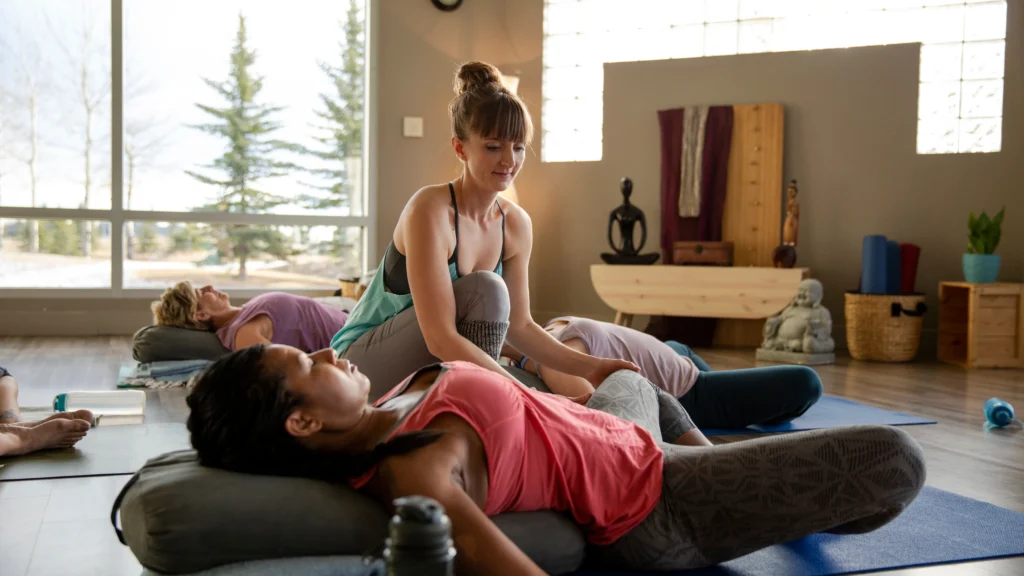
I assume you’re just starting out or deepening your practice, seeking guidance is a smart move. Yoga is a journey, and having the right support can make all the difference. Here’s why reaching out for help is important and how to find the best guidance for your needs:
Why Seeking Guidance Matters
- Ensures Proper Technique: Learning correct alignment and techniques from the start prevents bad habits and reduces the risk of injuries.
- Personalized Advice: A skilled teacher can offer modifications and adjustments tailored to your body and experience level.
- Boosts Confidence: Knowing you’re practicing safely and effectively builds confidence and enhances your overall experience.
- Deepens Understanding: Guidance from experienced practitioners can provide insights into the philosophy and deeper aspects of yoga.
Where to Find Guidance
- Attend Yoga Classes
- Joining a class is one of the best ways to receive direct feedback and instruction. Look for beginner-friendly classes at local studios or community centers.
- Hire a Private Instructor
- If you prefer personalized attention, consider hiring a private yoga instructor. They can focus on your individual needs, goals, and any specific challenges you’re facing.
- Use Online Resources
- There are countless online yoga classes and tutorials available. Platforms like YouTube, Yoga with Adriene, and Gaia offer classes for all levels, from beginner to advanced.
- Join a Yoga Community
- Engaging with a community of fellow yogis can provide support, motivation, and shared learning experiences. Look for local meetups or online groups and forums.
- Read Books and Articles
- Educate yourself with books and articles written by experienced yoga teachers. They can offer valuable insights into both the physical and philosophical aspects of yoga.
- Attend Workshops and Retreats
- Workshops and retreats offer immersive learning experiences where you can deepen your practice and learn from seasoned instructors.
Tips for Choosing the Right Guidance
- Check Qualifications
- Ensure your teacher or online resource is reputable and experienced. Look for certifications from recognized yoga organizations.
- Read Reviews and Testimonials
- Reviews and testimonials can provide insight into the experiences of others and help you choose the right instructor or resource.
- Trust Your Instincts
- Choose a teacher or resource that resonates with you. Feeling comfortable and inspired by your guide is crucial for a positive learning experience.
- Be Open to Feedback
- Constructive feedback is invaluable. Be open to suggestions and corrections, and use them to improve your practice.
Making the Most of Guidance
- Ask Questions
- Don’t hesitate to ask questions, whether in class, during a private session, or online. Clarifying doubts ensures you’re practicing correctly.
- Take Notes
- Keep a yoga journal to jot down tips, adjustments, and insights from your sessions. This helps reinforce learning and track your progress.
- Practice Regularly
- Consistency is key. Regular practice allows you to apply what you’ve learned and see steady improvement.
- Stay Curious
- Yoga is a lifelong journey. Stay curious, keep exploring, and continue seeking knowledge and guidance to enrich your practice.
Benefits of Seeking Guidance
- Enhanced Safety: Proper instruction reduces the risk of injury.
- Faster Progress: Personalized guidance helps you progress more quickly and effectively.
- Deeper Connection: Understanding the deeper aspects of yoga enhances your connection to the practice.
- Increased Motivation: Support and encouragement from teachers and peers keep you motivated and engaged.
Seeking guidance when needed ensures that your beginner yoga routine is safe, effective, and enjoyable. Embrace the support available to you and watch your practice flourish. Remember, even the most advanced yogis were beginners once, and seeking help is a sign of dedication to your growth and well-being. Namaste! 🌟🙏
Conclusion of Beginner Yoga Routine
Congrats, future yoga master! 🎉 You’ve taken the first steps on an incredible journey towards better health, peace, and self-discovery. Starting a beginner yoga routine can be both exciting and a bit daunting, but with these do’s and don’ts in mind, you’re well on your way to a rewarding and safe practice.
Recap of the Do’s and Don’ts
Let’s quickly recap the key points to keep your beginner yoga routine on the right track:
- Do: Create a Comfortable Practice Space
- Set up a calm, clutter-free area with the right props to enhance your practice.
- Don’t: Skip the Warm-Up
- Always warm up to prepare your body and prevent injuries.
- Do: Focus on Proper Alignment
- Pay attention to your form to maximize benefits and avoid injuries.
- Don’t: Push Yourself Too Hard
- Listen to your body’s limits and avoid overexertion.
- Do: Breathe Properly
- Use mindful breathing techniques to enhance relaxation and concentration.
- Don’t: Compare Yourself to Others
- Embrace your unique yoga journey and avoid the comparison trap.
- Do: Stay Consistent
- Regular practice is key to progress and long-term benefits.
- Don’t: Ignore Pain
- Respect your body’s signals and avoid pushing through pain.
- Do: Seek Guidance When Needed
- Utilize the support of instructors, classes, and resources to improve your practice.
Embrace Your Yoga Journey
Yoga is more than just physical exercise; it’s a holistic practice that nurtures your mind, body, and spirit. By following these do’s and don’ts, you’re setting a strong foundation for a lifelong practice. Remember, yoga is about progress, not perfection. Celebrate each small victory, be kind to yourself, and enjoy the journey.
Beginner yoga routine is a great way to start and maintain yoga as a habit. Following these do’s and don’ts to have special beginner yoga routine will boost your daily performance, increase your focus and easily regulate emotional well-being.
Everybody starts with a quick and easy beginner yoga routine. The beginner yoga routine has amazing beginner yoga routine practice in a day-to-day basis. You need more than you think of a beginner yoga routine.
So, roll out your mat, take a deep breath, and let the magic of yoga unfold. You’ve got this! 🌟 Namaste! 🙏
Read more about:




